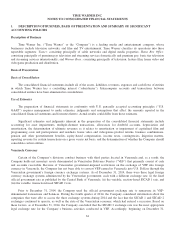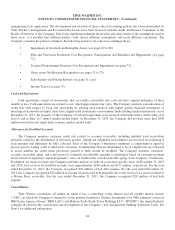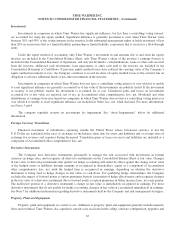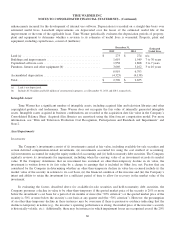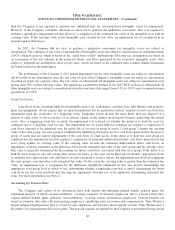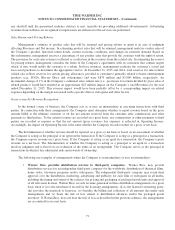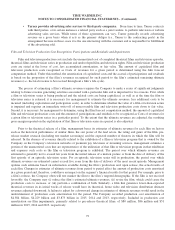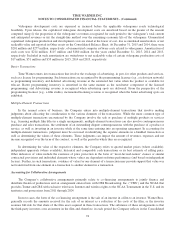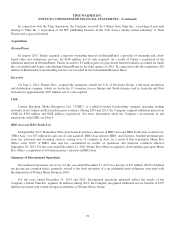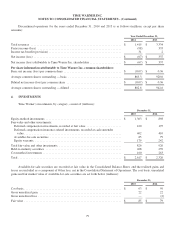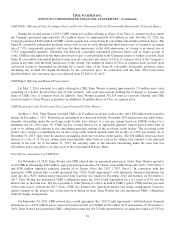Time Magazine 2015 Annual Report Download - page 85
Download and view the complete annual report
Please find page 85 of the 2015 Time Magazine annual report below. You can navigate through the pages in the report by either clicking on the pages listed below, or by using the keyword search tool below to find specific information within the annual report.TIME WARNER INC.
NOTES TO CONSOLIDATED FINANCIAL STATEMENTS - (Continued)
any shortfall until the guaranteed audience delivery is met, typically by providing additional advertisements. Advertising
revenues from websites are recognized as impressions are delivered or the services are performed.
Sales Returns and Pricing Rebates
Management’s estimate of product sales that will be returned and pricing rebates to grant is an area of judgment
affecting Revenues and Net income. In estimating product sales that will be returned, management analyzes vendor sales of
the Company’s product, historical return trends, current economic conditions, and changes in customer demand. Based on
this information, management reserves a percentage of any product sales that provide the customer with the right of return.
The provision for such sales returns is reflected as a reduction in the revenues from the related sale. In estimating the reserve
for pricing rebates, management considers the terms of the Company’s agreements with its customers that contain targets
which, if met, would entitle the customer to a rebate. In those instances, management evaluates the customer’s actual and
forecasted purchases to determine the appropriate reserve. At December 31, 2015 and 2014, total reserves for sales returns
(which also reflects reserves for certain pricing allowances provided to customers) primarily related to home entertainment
products (e.g., DVDs, Blu-ray Discs and videogames) and were $875 million and $1.000 billion, respectively. An
incremental change of 1% in the Company’s estimated sales returns rate (i.e., provisions for returns divided by gross sales of
related product) would have resulted in an approximate $43 million impact on the Company’s total Revenues for the year
ended December 31, 2015. This revenue impact would have been partially offset by a corresponding impact on related
expenses depending on the margin associated with a specific film or videogame and other factors.
Gross versus Net Revenue Recognition
In the normal course of business, the Company acts as or uses an intermediary in executing transactions with third
parties. In connection with these arrangements, the Company must determine whether to report revenue based on the gross
amount billed to the ultimate customer or on the net amount received from the customer after commissions and other
payments to third parties. To the extent revenues are recorded on a gross basis, any commissions or other payments to third
parties are recorded as expense so that the net amount (gross revenues less expense) is reflected in Operating Income.
Accordingly, the impact on Operating Income is the same whether the Company records revenue on a gross or net basis.
The determination of whether revenue should be reported on a gross or net basis is based on an assessment of whether
the Company is acting as the principal or an agent in the transaction. If the Company is acting as a principal in a transaction,
the Company reports revenue on a gross basis. If the Company is acting as an agent in a transaction, the Company reports
revenue on a net basis. The determination of whether the Company is acting as a principal or an agent in a transaction
involves judgment and is based on an evaluation of the terms of an arrangement. The Company serves as the principal in
transactions in which it has substantial risks and rewards of ownership.
The following are examples of arrangements where the Company is an intermediary or uses an intermediary:
•Warner Bros. provides distribution services to third-party companies. Warner Bros. may provide
distribution services for an independent third-party company for the worldwide distribution of theatrical films,
home video, television programs and/or videogames. The independent third-party company may retain final
approval over the distribution, marketing, advertising and publicity for each film or videogame in all media,
including the timing and extent of the releases, the pricing and packaging of packaged goods units and approval
of all television licenses. Warner Bros. records revenue generated in these distribution arrangements on a gross
basis when it (i) is the merchant of record for the licensing arrangements, (ii) is the licensor/contracting party,
(iii) provides the materials to licensees, (iv) handles the billing and collection of all amounts due under such
arrangements and (v) bears the risk of loss related to distribution advances and/or the packaged goods
inventory. If Warner Bros. does not bear the risk of loss as described in the previous sentence, the arrangements
are accounted for on a net basis.
71


